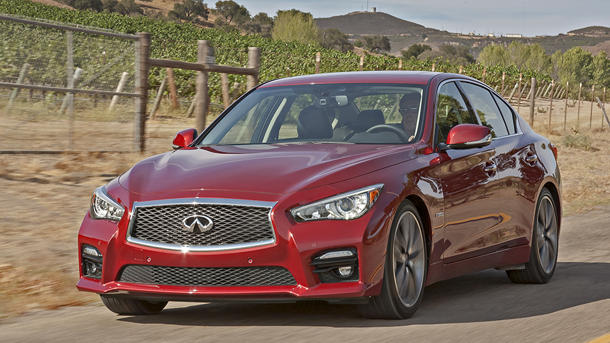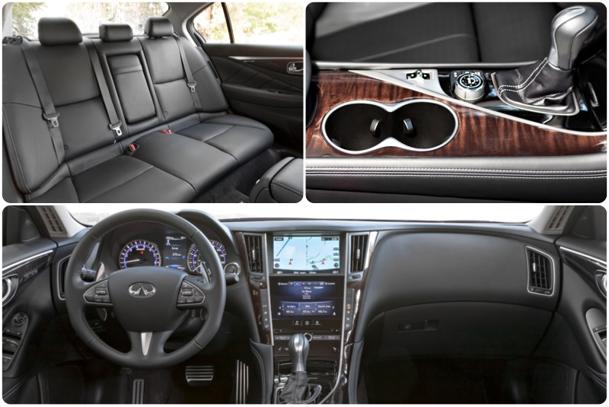Infiniti has a lot riding on the success of its all-new Q50 sports sedan. Not only is it replacing the beloved G37 Sedan in the Infiniti lineup, but it is the first vehicle to follow the company’s so called “controversial” new Q/QX naming convention, as well as the first vehicle built under the automaker’s new design and engineering philosophy. Infiniti hopes that by making its cars more luxurious and packing them with all kinds of technically-advanced bells and whistles it will finally join the premium luxury club with Audi, BMW, Lexus and Mercedes-Benz.
After spending some time with the sporty four-door recently, we think Infiniti has little to worry about and a lot to celebrate. In fact, we tend to agree with the company’s assessment (there’s a first time for everything): The Q50 is the best sports sedan Infiniti has ever built, and it is fully capable of competing nicely with the Audi A4, BMW 3-Series and Lexus IS.
However, that's not what has us so stoked about this car. Instead, it is the vehicle’s uncanny ability to drive itself that had us giggling like excited girls backstage at a Taylor Swift concert — and a wee bit anxious.
Though none are standard equipment, the Q50 can be outfitted with one of the most comprehensive array of electronic driver aids we’ve come across to date. For a little as $3,200, you get Direct Adaptive Steering, Active Lane Control, Blind-Spot Monitoring, Adaptive Cruise Control, and Predictive Forward Collision Warning, among other bells and whistles.
When all of the aids are engaged, the car will automatically keep itself a safe distance from the vehicle in front, stay centered in the lane, and even navigate around sweeping curves without any input from the driver. My co-pilot and I were able to “drive” for about 35 miles on a somewhat hilly, not-so-straight-but-not-so-curvy section of I-95 just north of Boston without touching the steering wheel, accelerator or brake pedal. It was incredible.
While other vehicles do feature similar “self-driving” experiences (the new Mercedes-Benz S-Class, for instance), the Q50 is unique in that it uses Direct Adaptive Steering, Infiniti’s version of a drive-by-wire electrical steering system, to initiate course corrections instead of using its brakes to change the vehicle’s trajectory. The car steers itself. The driver is simply there to keep the vehicle from going completely off the rails.
Is it cool? Hell yes. Will it pose a potential problem for some drivers? Definitely.
Lane Control has particular radius of turn that it can tolerate before requesting driver intervention — it can only navigate around a certain angle before the system alerts and diverts back to driver control. Unfortunately, that angle isn't always consistent. My co-pilot and I both agreed that the vehicle often hugged the lane markers a little too close or too long for our comfort before steering back into the center of the lane. Even more concerning was that the system gives little notice when its limit is reached, letting the car simply drift into the adjacent lane whether there is a car in it or not.
For this reason, the system is only good for highway driving, and not precise or reliable enough for crowded city or suburban driving. We tried it around Boston and several Northeast enclaves. More often than not, we wound up facing oncoming traffic or hurdling toward a ditch, gulley or guardrail.
In addition, when working together the driver aids can make the driver feel like a useless redundancy. It’s sort of like the astronauts aboard Discovery One in film “2001: A Space Odyssey” must have felt when they realized Hall 9000 was taking over and in the process getting rid of them. Thankfully, the semi-sentient systems in the Q50 can be turned on and off without a spacesuit.
At first glance, the Q50 looks similar to the outgoing model, mainly because it rides on the same 112.2-inch wheelbase as the G37 and shares a lot of the same stylish bits and pieces. In fact, it is slightly lower, longer, and wider than its predecessor, and a new “double arch” front grille, LED headlights and daytime running lights add to the aggressive look.
Inside, the transformation is much more dramatic. Upgrades in materials and presentation also make the Q50 exponentially more luxurious than the G37. And thanks to an increase in interior volume by 13 cu. ft., there seems to be lot more head and shoulder room.
The most noticeable change, however, is the dashboard. It adopts a new dual-cowl look and features a center stack dominated by two touch-screens, stacked on top of one another. The on-screen menus are well though-out ad fully customizable. They control all aspects of the HVAC and infotainment systems as well as vehicle settings. Both are fairly intuitive and easy to navigate. That said, like many LCDs, these suffer from being somewhat reflective, making them hard to read in direct sunlight.
For those who prefer physical switchgear, Infiniti has opted to provide hard buttons for primary audio control (including an actual volume knob, novelty of novelties) and climate control functions, including temperature, fan speed, airflow and seat heaters, too.
Engine options include the latest version of Nissan/Infiniti's widely used 3.7-liter V-6 as well as a hybrid. While the-liter V6 is rated at 328 hp and 269 lb-ft of torque, it is essentially carry-over, with a fuel economy rating of 20/29 mpg city/highway in rear-wheel-drive editions.
However, the hybrid is all new. It combines a 3.5-liter V-6 and compact laminated lithium-ion battery design with an innovative one-motor/two-clutch motor control. The system's V-6 is rated at 302 horsepower and 258 lb-ft of torque, while the advanced 50 kW electric motor is rated at 67 hp and 214 lb-ft of torque. Net power is 360 hp, providing strong acceleration and lean fuel economy of 29/36 mpg.
The Q50 comes standard with a conventional power-assisted rack-and-pinion steering system. However, the real news here is the optional Direct Adaptive Steering — the first time an automaker has offered a drive-by-wire setup.
When powered on, there is no mechanical connection between the steering wheel and the front tires. Input from the driver is relayed to a computer, which then relays those instructions to the front wheels. DAS allows independent control of the Q50's tire angle and steering inputs and is supposed to translate a driver’s intentions to the wheels faster than a mechanical system.
Truthfully, there is nothing inherently wrong with this type of electrical steering. And this one is quite good. There is one problem, though: DAS provides little to no feedback through the steering wheel.
Performance-oriented drivers, the kind Infiniti caters to, tend to hate electric-boosted power steering which provides less information about what the tires are up to than traditional hydraulic-powered systems. In this case, we were disappointed by the dead stick feeling at first. But we quickly got used to it. Why? It reacted swiftly and accurately to any input,and conquered the road with surgical proficiency.
Did it feel weird? Yes. Did it perform like a champ? Definitely.
When on throttle, overall performance feels very similar to the G37, whether you’re driving the hybrid or the gas-powered model, which shouldn’t come as a huge surprise given engine outputs remain relatively unchanged and curb weight is nearly identical. Both cars were fast, has a stiff, yet comfortable ride, exhibited precise handling, and the modifications made to isolate the chassis from noise and vibration were quite impressive in the Q50.
It's enough to wonder why you'd let the computers ever drive for you.
Source: Yahoo!



No comments:
Post a Comment